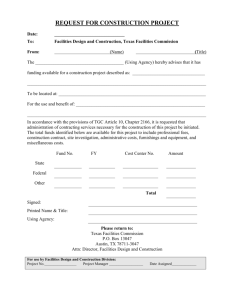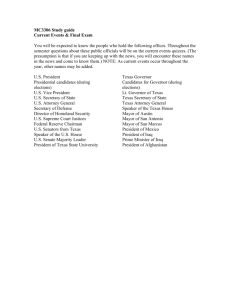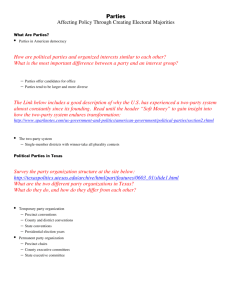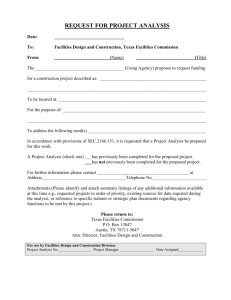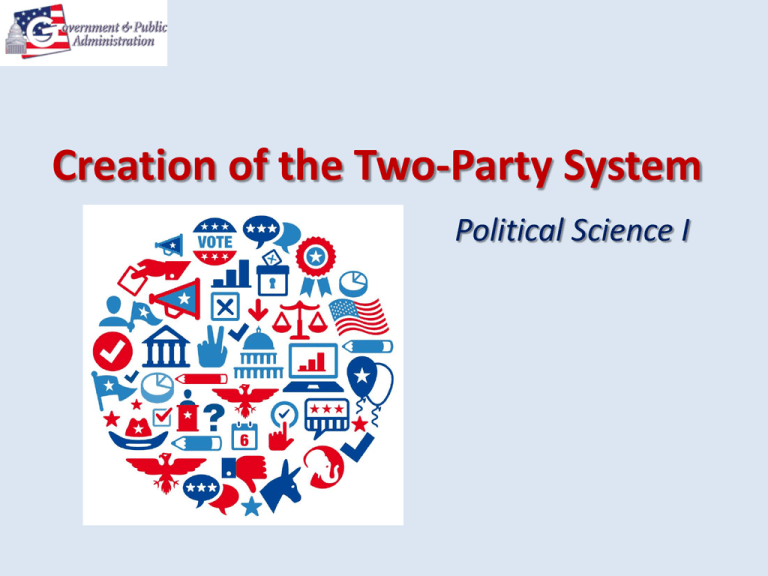
Creation of the Two-Party System
Political Science I
Copyright and Terms of Service
Copyright © Texas Education Agency, 2014. These materials are copyrighted © and trademarked
™ as the property of the Texas Education Agency (TEA) and may not be reproduced without the
express written permission of TEA, except under the following conditions:
1) Texas public school districts, charter schools, and Education Service Centers may reproduce
and use copies of the Materials and Related Materials for the districts’ and schools’
educational use without obtaining permission from TEA.
2) Residents of the state of Texas may reproduce and use copies of the Materials and Related
Materials for individual personal use only, without obtaining written permission of TEA.
3) Any portion reproduced must be reproduced in its entirety and remain unedited, unaltered
and unchanged in any way.
4) No monetary charge can be made for the reproduced materials or any document containing
them; however, a reasonable charge to cover only the cost of reproduction and distribution
may be charged.
Private entities or persons located in Texas that are not Texas public school districts, Texas
Education Service Centers, or Texas charter schools or any entity, whether public or private,
educational or non-educational, located outside the state of Texas MUST obtain written approval
from TEA and will be required to enter into a license agreement that may involve the payment of
a licensing fee or a royalty.
Contact TEA Copyrights with any questions you may have.
Copyright © Texas Education Agency 2014. All rights reserved.
Images and other multimedia content used with permission.
2
How did the two-party political
system begin in the US?
Copyright © Texas Education Agency 2014. All rights reserved.
Images and other multimedia content used with permission.
3
Roots of the Two-party System
• The evolution of the US’s political parties can be
divided into seven different periods
• 1789-1816: The creation of the parties
• 1816-1828: The era of one-party rule, or personal politics
• 1828-1860: The period from Andrew Jackson’s Presidency
to just before the Civil War
• 1860-1896: The Civil War and Post Civil-War
• 1896-1932: The Republican ascendency and the
Progressive Period
• 1932-1968: The New Deal Period
• 1968 to the present: The Modern Period
Copyright © Texas Education Agency 2014. All rights reserved.
Images and other multimedia content used with permission.
4
Roots of the Two-party System
(continued)
• The two-party system in the US has been around since
about 1800
• The first political division in the US occurred just
before the adoption of the US Constitution
• In the years after the ratification of the US Constitution,
the US eventually experienced the evolution of the twoparty system
• George Washington strongly opposed the concept of
political parties
• After George Washington stepped down after two
terms, the first political parties were present in the
presidential election of 1796
Copyright © Texas Education Agency 2014. All rights reserved.
Images and other multimedia content used with permission.
5
US Has Always Been
A Two-party System
• There are many minor parties around in the US
•
•
•
•
•
Libertarian Party
Socialist Party
Reform Party
Green Party
All minor parties rarely have a chance to win a
major office, but they can affect elections
• The core function of both political parties in
the US is to win elections
Copyright © Texas Education Agency 2014. All rights reserved.
Images and other multimedia content used with permission.
6
What is the historical timeline of
the Republican Party in the US?
Copyright © Texas Education Agency 2014. All rights reserved.
Images and other multimedia content used with permission.
7
Republican Party Rose in the 1850s
• The Republican Party began as the
“antislavery party”
• In 1860, the Republicans elected their first
President of the US, Abraham Lincoln
• The election of Abraham Lincoln helped to ignite
the Civil War
• The Republican Party thrived for more than 60
years
• The Republicans controlled most of the North
while the Democrats controlled the South
Copyright © Texas Education Agency 2014. All rights reserved.
Images and other multimedia content used with permission.
8
Republican Party Rose in the 1850s
(continued)
• The second Republican era was initiated by a
bitter presidential election between Democrat
William Jennings Bryan and Republican William
McKinley
• The Republicans favored the gold standard,
industrialization, banking, high tariffs, and the working
industrial class
• The Republicans remained the nation’s majority
party until the stock market crashed in 1929,
causing the Great Depression
Copyright © Texas Education Agency 2014. All rights reserved.
Images and other multimedia content used with permission.
9
Republicans Remained Silent until the
Election of 1952
• Dwight Eisenhower was the first Republican
elected to the office of the Presidency since
Herbert Hoover
• Eisenhower did not reignite the Republicans’
momentum with his election
• Eisenhower served two terms as President before being
replaced by Democratic candidate John F. Kennedy
• During Eisenhower’s presidency, the Democrats
controlled the House and the Senate in every
congressional term except 1953-1955
Copyright © Texas Education Agency 2014. All rights reserved.
Images and other multimedia content used with permission.
10
The Shift of the South
• After Eisenhower, the Democrats remained in
control of the Presidency until the election of
Richard Nixon in 1968
• Nixon formulated the “southern strategy,” which
emphasized supporting states’ rights, law and
order, and strong military posture in Vietnam
• The South began to slowly shift in favor of the
Republicans in 1968 and is currently a Republican
stronghold
Copyright © Texas Education Agency 2014. All rights reserved.
Images and other multimedia content used with permission.
11
What is the historical timeline of
the Democratic Party in the US?
Copyright © Texas Education Agency 2014. All rights reserved.
Images and other multimedia content used with permission.
12
The Democratic Republicans
• The party that finally challenged the Federalist
Party after President John Adams was the
Democratic-Republican Party
• The Democratic-Republican Party was led by
Virginians: Thomas Jefferson, James Madison, and
James Monroe
• This party derived its coalition from agrarian interests
rather than from the growing number of capitalists
who supported the Federalists
• By 1816, the Federalist Party had virtually collapsed
and two-party competition did not really exist
Copyright © Texas Education Agency 2014. All rights reserved.
Images and other multimedia content used with permission.
13
The Democratic Republicans
(continued)
• In 1828 Andrew Jackson was elected to be President of the
US and founded the modern American political party known
as the Democrats
• The Democratic Party was a coalition of Westerners,
Southerners, and new immigrants
• Jackson was initially a Democratic-Republican, but when he
became President he quickly dropped the “Republican” and his
party became simply known as the Democrats
• The policy of these Democrats was to broaden political
opportunity to the American people by eliminating elitism and
mobilizing the masses
• The competition among the Democrats and the Whigs was
fierce, closely matched, and brought the US its first broadly
supported two-party system
Copyright © Texas Education Agency 2014. All rights reserved.
Images and other multimedia content used with permission.
14
The Silent Era for
the Democratic Party
• The Republican Party entered an era of dominance during
the Civil War Era
• Political machines started to gain control of local and state
government, fueled by immigration from Europe
• Although political machines like Tammany Hall were corrupt
and disrupted the political process, they generated widespread
political participation and helped to integrate immigrants to the
political process
• The Democrats attempted to end the age of Republican
dominance by running William Jennings Bryan as the
Democratic presidential candidate in 1896
• Bryan lost the election to William McKinley, which laid the
foundation for Republican rule until the election of FDR in 1932
Copyright © Texas Education Agency 2014. All rights reserved.
Images and other multimedia content used with permission.
15
Democratic Dominance 1932-1968
• The stock market crash of 1929 sent the economy
into the Great Depression, which motivated the
election of FDR in 1932
• President Franklin D. Roosevelt urged for increased
governmental role in promoting the public welfare
• President FDR created the New Deal Coalition
• The Democrats remained in control of the Presidency,
the Senate, and the House of Representatives from
1932-1953
• The Republicans did not have a president until Dwight
D. Eisenhower in 1953
Copyright © Texas Education Agency 2014. All rights reserved.
Images and other multimedia content used with permission.
16
Democratic Dominance 1932-1968
(continued)
• The Vietnam Era
• The “Southern Strategy” waged by Republicans
during the Vietnam War and the Civil Rights
Movement changed the once Democraticcontrolled South
• The Democrats have not had a stronghold in the
South since the late 1980s
Copyright © Texas Education Agency 2014. All rights reserved.
Images and other multimedia content used with permission.
17
How has the two-party system
changed in the US?
Copyright © Texas Education Agency 2014. All rights reserved.
Images and other multimedia content used with permission.
18
Moving Away from “Party Politics”
• Candidate-centered politics
• Following World War II, politics began to shift away
from political parties to focus more on the actual
candidate who was running
• Candidate-centered politics focuses on the candidates’
particular issues and character
• Candidates started to have more power in how they
conducted their campaigns and how they obtained
resources
• Candidates became very reliant on interest groups and
lobbyists for support
Copyright © Texas Education Agency 2014. All rights reserved.
Images and other multimedia content used with permission.
19
Moving Away from “Party Politics”
(continued)
• Party machines decline
• The flow of immigrants dropped dramatically during
and after World War II, so party machines lost power
in many urban cities
• FDR and the New Deal Coalition replaced the idea of
the party machines because social services began to be
seen as a right, not a privilege
• During the era of party machines, citizens were very
loyal to their political parties and many presidential
elections saw a voter turnout of 75 percent or higher
Copyright © Texas Education Agency 2014. All rights reserved.
Images and other multimedia content used with permission.
20
Current Organization of the
Two Political Parties
• The National Party
• The national party for the two parties is the pinnacle of
the party system in the US
• The primary function of the national parties is to
establish a unified vision in which citizens can identify
nationwide
• The national parties are supposed to represent the
diversity of the citizens throughout the US
• The national parties also help fund particular
candidates throughout the US in local and state
elections to ensure that their political candidate gets
elected into office
Copyright © Texas Education Agency 2014. All rights reserved.
Images and other multimedia content used with permission.
21
Current Organization of the
Two Political Parties (continued)
• The State Party
• The state parties have become significantly more
effective over the past several decades
• The state political parties are made up of a
collection of local party organizations
• These state parties are very influential in getting a
particular candidate elected
Copyright © Texas Education Agency 2014. All rights reserved.
Images and other multimedia content used with permission.
22
Current Organization of the
Two Political Parties (continued)
• The Local Party
• The local parties act as the foot soldiers for the
state and national parties
• The local parties are often supplemented by funds
from the state and national parties
• Local parties are always working to enhance party
loyalty of voters
• Grassroots campaigns begin at the local level
Copyright © Texas Education Agency 2014. All rights reserved.
Images and other multimedia content used with permission.
23
How does a candidate get
elected to run for office?
Copyright © Texas Education Agency 2014. All rights reserved.
Images and other multimedia content used with permission.
24
Types of Elections:
Primary Elections
• Voters decide which of the candidates within a
party will represent the party in the general
election
• Primaries are elections between candidates from
the same party
• Primaries occur in two different forms
• Closed primaries – a primary election in which only a
party’s registered voters are eligible to cast a ballot
• Open primaries – a primary election in which party
members, independents, and sometimes members of
the other party are allowed to participate
Copyright © Texas Education Agency 2014. All rights reserved.
Images and other multimedia content used with permission.
25
Types of Elections:
Runoff Elections
• Runoff primaries are elections that occur in states in which
one of the primary candidates must receive 50 percent of
the votes
• Texas has runoff primary elections; candidates must receive 50
percent of the votes in the initial primary election
• The runoff primaries are narrowed down to the two
candidates from the initial primary elections who received
the most votes
• One of the candidates is guaranteed to receive a majority of the
votes in the runoff primary
• The candidate that wins the primary election is the party
representative in the general election in November
Copyright © Texas Education Agency 2014. All rights reserved.
Images and other multimedia content used with permission.
26
Types of Elections:
Caucuses
• This is the oldest, most party-orientated
method of choosing a candidate
• The caucus used to be a closed meeting of
party activists in each state that selected the
party’s presidential candidate
• Today, caucuses are more open and attract a widerrange of party participants
Copyright © Texas Education Agency 2014. All rights reserved.
Images and other multimedia content used with permission.
27
Types of Elections:
General Election
• Voters decide which candidates actually fill
elective public offices
• These elections are held at the municipal,
county, state, and national levels
• General elections are elections between
candidates from opposing parties
Copyright © Texas Education Agency 2014. All rights reserved.
Images and other multimedia content used with permission.
28
Campaigning: Fundraising
• Fundraising is the most important function that
candidates must do to ensure their victory in an election
• Fundraising can be obtained from individuals, political
parties, and Political Action Committees (PACs)
• PACs are fundraising organizations that represent the
interests groups in the political process
• Fundraising is used to purchase television air time,
informational pamphlets, and yard signs, to pay
political consultants as well as many more activities
• Candidates often host fundraising events to help raise
money for their campaign
Copyright © Texas Education Agency 2014. All rights reserved.
Images and other multimedia content used with permission.
29
Campaign Effectiveness
• Are they worth it?
• Over 50 years of research on political campaigns
has led to the conclusion that campaigns reinforce
and activate; they rarely convert
• Most people pay little attention to campaigns and
have selective perception
• Long term party affiliation influences voting
behavior regardless of a campaign
• Incumbents have a substantial advantage over their
competing candidates
Copyright © Texas Education Agency 2014. All rights reserved.
Images and other multimedia content used with permission.
30
Resources
• Edwards, George, Martin Wattenberg, and Robert Lineberry.
Government in America: People, Politics and Policy. 15. New York
City: Longman, 2011. Chapter 17 & 21. Print.
• Harrison, Brigid, and Jean Harris. American Democracy Now. 2.
New York City: McGraw Hill Company, 2011. Chapter 15 & 18.
Print.
• O'Conner, Karen, Larry Sabato, and Alixandra Yanus. American
Government: Roots and Reform. 2011. New York City: Longman,
2011. Chapter 4 & 18. Print.
• Patterson, Thomas. The American Democracy. 9th. New York City:
McGraw Hill Higher Education, 2009. Ch. 15 & 18. Print.
• Schmidt, Steffan, Mack Shelley, Barbara Bardes, and Lynne Ford.
American Government and Politics Today. 2011-2012. Boston:
Wadsworth Cenage Learning, 2012. Chapter 17 &19. Print.
Copyright © Texas Education Agency 2014. All rights reserved.
Images and other multimedia content used with permission.
31


